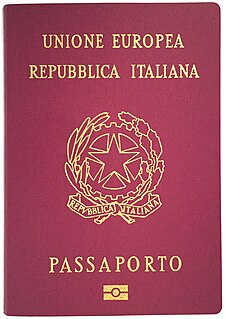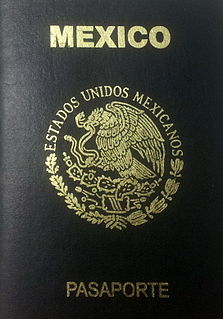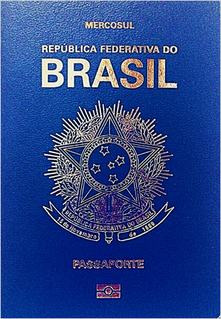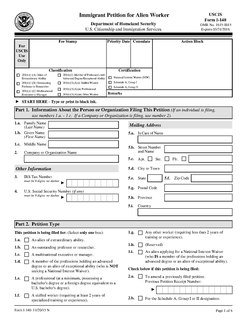Related Research Articles

A green card, known officially as a permanent resident card, is an identity document which shows that a person has permanent residency in the United States. Green card holders are formally known as lawful permanent residents (LPRs). As of 2019, there are an estimated 13.9 million green card holders of whom 9.1 million are eligible to become United States citizens. Approximately 65,000 of them serve in the U.S. Armed Forces.

A visa is a conditional authorization granted by a territory to a foreigner, allowing them to enter, remain within, or to leave that territory. Visas typically may include limits on the duration of the foreigner's stay, areas within the country they may enter, the dates they may enter, the number of permitted visits or an individual's right to work in the country in question. Visas are associated with the request for permission to enter a territory and thus are, in most countries, distinct from actual formal permission for an alien to enter and remain in the country. In each instance, a visa is subject to entry permission by an immigration official at the time of actual entry, and can be revoked at any time. A visa most commonly takes the form of a sticker endorsed in the applicant's passport or other travel document.
The Visa Waiver Program (VWP) is a program of the U.S. federal government that allows citizens of specific countries to travel to the United States for tourism, business, or while in transit for up to 90 days without having to obtain a visa. The program applies to the 50 states and District of Columbia, as well as Puerto Rico and the U.S. Virgin Islands, with limited application to other U.S. territories.

The visa policy of the United States deals with the requirements which a foreign national wishing to enter the United States must meet to obtain a visa, which is a permit to travel to, enter, and remain in the United States. Visitors to the United States must obtain a visa from one of the United States diplomatic missions unless they come from one of the visa-exempt countries or Visa Waiver Program countries. The same rules apply to Puerto Rico, United States Virgin Islands, Guam and the Northern Mariana Islands, while different rules apply to American Samoa. Although the US visa policy applies to Guam and the CNMI, the two territories also have their own visa waiver program.

The visa policy of the Schengen Area is set by the European Union and applies to the Schengen Area and to other EU member states except Ireland. The visa policy allows nationals of certain countries to enter the Schengen Area via air, land or sea without a visa for stays of up to 90 days within a 180-day period. Nationals of certain other countries are required to have a visa either upon arrival or in transit.

Visitors to the Republic of China (Taiwan) must obtain a visa or authorization in advance, unless they come from one of the visa exempt countries or countries whose nationals are eligible for visa on arrival. All visitors must hold a passport valid for 6 months.

Visa requirements for United States citizens and non-citizen nationals are administrative entry restrictions by the authorities of other states placed on citizens of the United States.

Visa requirements for Indian citizens are administrative entry restrictions by the authorities of other states placed on citizens of India. As of 1 July 2020, Indian citizens had visa-free or visa on arrival access to 58 countries and territories, ranking the Indian passport 85th in terms of travel freedom according to the Henley Passport Index. With visa free entry to 18 countries and visa on arrival facility to 34 countries India shares 60th rank in Global Passport Power Rank.

Visa requirements for South Korean citizens are administrative entry restrictions by the authorities of other states placed on citizens of South Korea.

Visa requirements for Italian citizens are administrative entry restrictions by the authorities of other states placed on citizens of Italy. As of 7 April 2020, Italian citizens had visa-free or visa on arrival access to 186 countries and territories, ranking the Italian passport 4th in terms of travel freedom according to the Henley Passport Index. Additionally, the World Tourism Organization also published a report on 15 January 2016 ranking the Italian passport 1st in the world in terms of travel freedom, with the mobility index of 160.

Visa requirements for Mexican citizens are administrative entry restrictions by the authorities of other states placed on citizens of Mexico. As of 7 April 2020, Mexican citizens had visa-free or visa on arrival access to 159 countries and territories ranking the Mexican passport 24th in terms of travel freedom according to the Henley Passport Index.

Visa requirements for Brazilian citizens are administrative entry restrictions by the authorities of other states placed on citizens of Brazil. As of 13 October 2020, Brazilian citizens had visa-free or visa on arrival access to 170 countries and territories, ranking the Brazilian passport 18th in terms of travel freedom, according to the Henley Passport Index.

Visa requirements for South African citizens are administrative entry restrictions by the authorities of other states placed on citizens of South Africa. As of 1 October 2019, South African citizens had visa-free or visa on arrival access to 100 countries and territories, ranking the South African passport 53rd in terms of travel freedom according to the Henley Passport Index.

Visa requirements for Cambodian citizens are administrative entry restrictions imposed on citizens of Cambodia by the authorities of other states. As of 28 September 2019, Cambodian citizens had visa-free or visa on arrival access to 53 countries and territories, ranking the Cambodian passport 88th in terms of travel freedom according to the Henley & Partners Passport Index. Cambodia is also a part of ASEAN and has visa-free access to these countries and vice versa.
An A Visa is a category of non-immigrant visas allowing travel to the United States issued to ambassadors, diplomats, government officials, and their support staff.

Form I-140, Immigrant Petition for Alien Worker is a form submitted to the United States Citizenship and Immigration Service (USCIS) by a prospective employer to petition an alien to work in the US on a permanent basis. This is done in the case when the worker is deemed extraordinary in some sense or when qualified workers do not exist in the US. The employer who files is called the petitioner, and the alien employee is called the beneficiary; these two can coincide in the case of a self-petitioner. The form is 6 pages long with a separate 10-page instructions document as of 2016. It is one of the USCIS immigration forms.
The C-1 visa is a type of visa reserved for immediate and continuous transit through the United States to a foreign country. Interviews are not required for individuals younger than 13 or older than 80. Recipients are not eligible for an extension or change of status, and must possess sufficient funds to effect transit and enter the destination foreign country. The maximum term of stay is 29 days.
The C-2 visa is a non-immigrant visa which allows individuals to travel to United States for the purpose of immediate and continuous transit to or from the headquarters of the United Nations, or for United Nations officials transiting the US to another foreign nation. The holders of such a visa are considered "geographically restricted nonimmigrants".
The NATO-1 visa is a non-immigrant visa which allows representatives from NATO member states, their official staff, and their immediate family members to travel to United States. Recipients are normally exempt from inspection, and the visa is valid for the duration of the individual's stay in the US.
The S-5 visa is a non-immigrant visa which allows travel to United States for individuals who are witnesses, informants, or otherwise supplying information regarding a criminal organization and whose presence in the US is necessary for law enforcement to pursue investigation or prosecution. The S visa class, including the S-5 and S-6 visas, was created in 1994 by the Violent Crime Control and Law Enforcement Act.
References
- 1 2 Immigration pocket field guide. Matthew Bender & Company, Inc. 2013. p. 20.
- ↑ "Transit Visa". US Department of State Bureau of Consular Affairs. Archived from the original on 11 October 2016. Retrieved 11 October 2016.